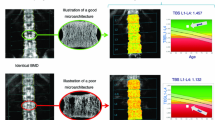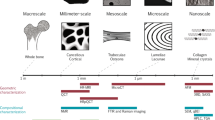Abstract
Osteoporosis is a metabolic disorder that manifests changes in bone density and structure accompanied by an increased susceptibility to fractures. Recent studies have demonstrated the potential contributions of trabecular bone microarchitecture in the assessment of the therapeutic efficacy of emerging treatments, and also in the assessment of fracture risk. The main goal of this paper is to emphasize the clinical implementation of bone microarchitecture measurements. Thus, this paper provides an overview of the main imaging modalities for depicting trabecular bone microarchitecture and a corresponding description of common computed structural bone parameters. The imaging modalities presented to characterize the complex three-dimensional trabecular bone network include micro-CT, quantitative CT, and magnetic resonance imaging. Two-dimensional analyses of radiographic patterns are also discussed. Results demonstrating the ability to distinguish between different populations based on trabecular bone microarchitecture in longitudinal studies are also presented for the various imaging modalities.
Similar content being viewed by others
References and Recommended Reading
Simon LS: Osteoporosis. Clin Geriatr Med 2005, 21:603–629.
Majumdar S, Newitt D, Jergas M, et al.: Evaluation of technical factors affecting the quantfiation of trabecular bone structure using magnetic resonance imaging. Bone 1995, 17:417–430.
Frost HM: Dynamics of bone remodelling. In Bone Biodynamics. Edited by Frost HM. Boston: Little Brown; 1964:315–334.
Marcus R: Clinical review 76: the nature of osteoporosis. J Clin Endocrinol Metab 1996, 81:1–5.
Caligiuri P, Giger ML, Favus MJ, et al.: Computerized radiographic analysis of osteoporosis: preliminary evaluation. Radiology 1993, 186:471–474.
Assessment of fracture risk and its application to screening for postmenopausal osteoporosis. Report of a WHO Study Group. World Health Organ Tech Rep Ser 1994, 843:1–129.
Link TM, Guglielmi G, van Kuijk C, et al.: Radiologic assessment of osteoporotic vertebral fractures: diagnostic and prognostic implications. Eur Radiol 2005, 15:1521–1532.
Cortet B, Dubois P, Boutry N, et al.: Image analysis of the distal radius trabecular network using computed tomography. Osteoporos Int 1999, 9:410–419.
Cortet B, Bourel P, Dubois P, et al.: CT scan texture analysis of the distal radius: influence of age and menopausal status. Rev Rhum Engl Ed 1998, 65:109–118.
Link TM, Majumdar S, Lin JC, et al.: A comparative study of trabecular bone properties in the spine and femur using high resolution MRI and CT. J Bone Miner Res 1998, 13:122–132.
Jiang Y, Zhao J, Augat P, et al.: Trabecular bone mineral and calculated structure of human bone specimens scanned by peripheral quantitative computed tomography: relation to biomechanical properties. J Bone Miner Res 1998, 13:1783–1790.
Ito M, Ikeda K, Nishiguchi M, et al.: Multi-detector row CT imaging of vertebral microstructure for evaluation of fracture risk. J Bone Miner Res 2005, 20:1828–1836.
Link TM, Vieth V, Stehling C, et al.: High-resolution MRI vs multislice spiral CT: which technique depicts the trabecular bone structure best? Eur Radiol 2003, 13:663–671.
Chevalier F, Laval-Jeantet A, Laval-Jeantet M, et al.: CT image analysis of the vertebral trabecular network in vivo. Calcif Tissue Int 1992, 51:8–13.
Link TM, Majumdar S, Lin J, et al.: Assessment of trabecular structure using high resolution CT images and texture analysis. J Comput Assist Tomogr 1998, 22:15–24.
Mundinger A, Wiesmeier B, Dinkel E, et al.: Quantitative image analysis of vertebral body architecture: improved diagnosis in osteoporosis based on high-resolution computed tomography. Osteoporos Int 1993, 3:138–147.
Chesnut CH 3rd, Majumdar S, Newitt DC, et al.: Effects of salmon calcitonin on trabecular microarchitecture as determined by magnetic resonance imaging: results from the QUEST study. J Bone Miner Res 2005, 20:1548–1561. Article demonstrating the efficacy of MRI technology for assessment of trabecular bone microarchitecture in clinical research trials.
Krug R, Banerjee S, Han ET, et al.: Feasibility of in vivo structural analysis of high-resolution magnetic resonance images of the proximal femur. Osteoporosis Int 2005, 16:1307–1314.
Muller R, Hildebrand T, Ruegsegger P: Non-invasive bone biopsy: A new method to analyze and display three dimensional structure of trabecular bone. Phys Med Biol 1994, 39:145–164.
Muller R, Hahn M, Vogel M, et al.: Morphometric analysis of noninvasively assessed bone biopsies: comparison of high-resolution computed tomography and histologic sections. Bone 1996, 18:215–220.
Muller R, Hildebrand T, Hauselmann HJ, et al.: In vivo reproducibility of three-dimensional structural properties of noninvasive bone biopsies using 3D-pQCT. J Bone Miner Res 1996, 11:1745–1750.
Boutroy S, Bouxsein ML, Munoz F, et al.: In vivo assessment of trabecular bone microarchitecture by high-resolution peripheral quantitative computed tomography. J Clin Endocrinol Metab 2005, 90:6508–6515. Article showing preliminary in vivo results of HR-pQCT technology. This article makes HR-pQCT appear promising to assess bone density and microarchitecture at peripheral sites in terms of reproducibility and ability to detect age- and disease-related changes.
Khosla S, Riggs BL, Atkinson EJ, et al.: Effects of sex and age on bone microstructure at the ultradistal radius: a population-based noninvasive in vivo assessment. J Bone Miner Res 2006, 21:124–131. Article showing preliminary in vivo results of HR-pQCT technology. This article makes HR-pQCT appear promising to assess bone density and microarchitecture at peripheral sites in terms of reproducibility and ability to detect age- and disease-related changes.
Newitt DC, van Rietbergen B, Majumdar S: Processing and analysis of in vivo high resolution MR images of trabecular bone for longitudinal studies: reproducibility of structural measures and micro-.nite element analysis derived mechanical properties. Osteoporos Int 2002, 13:278–287.
Ulrich D, van Rietbergen B, Laib A, et al.: The ability of three-dimensional structural indices to reflect mechanical aspects of trabecular bone. Bone 1999, 25:55–60.
Riggs BL, Hodgson SF, O’Fallon WM, et al.: Effect of fluoride treatment on the fracture rate in postmenopausal women with osteoporosis. N Engl J Med 1990, 332:802–809.
Laib A, Beuf O, Issever A, et al.: Direct measures of trabecular bone architecture from MR images. Adv Exp Med Biol 2001, 496:37–46.
Barou O, Valentin D, Vico L, et al.: High-resolution threedimensional micro-computed tomography detects bone loss and changes in trabecular architecture early: comparison with DEXA and bone histomorphometry in a rat model of disuse osteoporosis. Invest Radiol 2002, 37:40–46.
Waarsing JH, Day JS, Weinans H: Longitudinal micro-CT scans to evaluate bone architecture. J Musculoskelet Neuronal Interact 2005, 5:310–312.
Thomsen JS, Laib A, Koller B, et al.: Stereological measures of trabecular bone structure: comparison of 3D micro computed tomography with 2D histological sections in human proximal tibial bone biopsies. J Microsc 2005, 218(Pt 2):171–179.
Recker R, Masarachia P, Santora A, et al.: Trabecular bone microarchitecture after alendronate treatment of osteoporotic women. Curr Med Res Opin 2005, 21:185–194.
Ito M: Assessment of bone quality using micro-computed tomography (micro-CT) and synchrotron micro-CT. J Bone Miner Metab 2005, 23(Suppl):115–121.
Ding M, Odgaard A, Hvid I: Changes in the three-dimensional microstructure of human tibial cancellous bone in early osteoarthritis. J Bone Joint Surg Br 2003, 85:906–912.
Blumenkrantz G, Lindsey CT, Dunn TC, et al.: A pilot, two-year longitudinal study of the interrelationship between trabecular bone and articular cartilage in the osteoarthritic knee. Osteoarthritis Cartilage 2004, 12:997–1005.
Hudelmaier M, Kollstedt A, Lochmuller EM, et al.: Gender differences in trabecular bone architecture of the distal radius assessed with magnetic resonance imaging and implications for mechanical competence. Osteoporos Int 2005, 16:1124–1133.
Beuf O, Newitt DC, Mosekilde L, et al.: Trabecular structure assessment in lumbar vertebrae specimens using quantitative magnetic resonance imaging and relationship with mechanical competence. J Bone Miner Res 2001, 16:1511–1519.
Link TM, Vieth V, Langenberg R, et al.: Structure analysis of high resolution magnetic resonance imaging of the proximal femur: in vitro correlation with biomechanical strength and BMD. Calcif Tissue Int 2003, 72:156–165.
Ouyang X, Selby K, Lang P, et al.: High resolution magnetic resonance imaging of the calcaneus: age-related changes in trabecular structure and comparison with dual x-ray absorptiometry measurements. Calcif Tissue Int 1997, 60:139–147.
Majumdar S, Kothari M, Augat P, et al.: High-resolution magnetic resonance imaging: three-dimensional trabecular bone architecture and biomechanical properties. Bone 1998, 22:445–454.
Majumdar S, Genant HK, Grampp S, et al.: Correlation of trabecular bone structure with age, bone mineral density, and osteoporotic status: in vivo studies in the distal radius using high resolution magnetic resonance imaging. J Bone Miner Res 1997, 12:111–118.
Laib A, Newitt DC, Lu Y, et al.: New model-independent measures of trabecular bone structure applied to in vivo high-resolution MR images. Osteoporos Int 2002, 13:130–136.
Link TM, Majumdar S, Augat P, et al.: In vivo high resolution MRI of the calcaneus: differences in trabecular structure in osteoporosis patients. J Bone Miner Res 1998, 13:1175–1182.
Herlidou S, Grebe R, Grados F, et al.: Influence of age and osteoporosis on calcaneus trabecular bone structure: a preliminary in vivo MRI study by quantitative texture analysis. Magn Reson Imaging 2004, 22:237–243.
Boutry N, Cortet B, Dubois P, et al.: Trabecular bone structure of the calcaneus: preliminary in vivo MR imaging assessment in men with osteoporosis. Radiology 2003, 227:708–717.
Link TM, Lotter A, Beyer F, et al.: Changes in calcaneal trabecular bone structure after heart transplantation: an MR imaging study. Radiology 2000, 217:855–862.
Benito M, Gomberg B, Wehrli FW, et al.: Deterioration of trabecular architecture in hypogonadal men. J Clin Endocrinol Metab 2003, 88:1497–1502.
Pothuaud L, Lespessailles E, Harba R, et al.: Fractal analysis of trabecular bone texture on radiographs: discriminant value in postmenopausal osteoporosis. Osteoporos Int 1998, 8:618–625.
Majumdar S, Link TM, Millard J, et al.: In vivo assessment of trabecular bone structure using fractal analysis of distal radius radiographs. Med Phys 2000, 27:2594–2599.
Prouteau S, Ducher G, Nanyan P, et al.: Fractal analysis of bone texture: a screening tool for stress fracture risk? Eur J Clin Invest 2004, 34:137–142.
Guggenbuhl P, Bodic F, Hamel L, et al.: Texture analysis of x-ray radiographs of iliac bone is correlated with bone micro-CT. Osteoporos Int 2006, 17:447–454.
Author information
Authors and Affiliations
Corresponding author
Rights and permissions
About this article
Cite this article
Carballido-Gamio, J., Majumdar, S. Clinical utility of microarchitecture measurements of trabecular bone. Curr Osteoporos Rep 4, 64–70 (2006). https://doi.org/10.1007/s11914-006-0004-7
Issue Date:
DOI: https://doi.org/10.1007/s11914-006-0004-7




